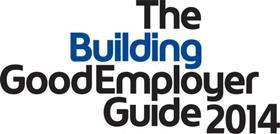Mental health issues can be difficult to detect in the workplace - which means they can also be easy to ignore. But as this year’s guide shows, the best employers are those that are ready and able to heed the warning signs


“Personally I don’t want to be sending people home to their families - their wives or husbands - ill. I have been through something like that and I don’t want it to happen to others.” This is the motivation behind the mental wellbeing initiative at contractor Bastows driven by Niki Rosenbaum, the firm’s cultural director. Despite being a small company
of just 28 staff, Bastows has over the past few years developed a comprehensive programme that covers everything from an annual wellbeing employee questionnaire to sending site managers on mental health first aid training days.
The fact that this policy (see box overleaf for more details) makes Bastows stand out in the industry is perhaps because, as a whole, construction has not had a great reputation when it comes to mental health awareness in the workplace. It’s a pressurised environment, with complex projects, ever shorter deadlines and tough financial targets. On top of that, there is a perception that a “macho” culture pervades in which people don’t talk about psychological problems and it’s up to the individual to prove they can handle the pressure and still perform. This is a recipe for high levels of stress, anxiety and depression.
Earlier in the year, ��ɫ����TV focused on the prevalence of these issues when it launched its ��ɫ����TV a Better Balance initiative during National Mental Health Awareness week.
The idea behind the editorial campaign is to draw attention to problems that often go unnoticed, and in doing so help make construction a healthier place to work. As
part of this effort, in the 2014 Good Employer Guide we added this question to the employee survey: “How approachable do you find your managers over mental wellbeing issues such as workplace stress?” We asked staff to rank their employer according to five options ranging from very approachable to very unapproachable. As you can see from the entries in the guide, the responses among firms selected as the industry’s top employers were overwhelming positive.
The business case
But why are companies in the guide choosing to invest substantial amounts of money in staff wellbeing? What are the benefits for businesses that go down this path? And is it realistic to expect the rest of the industry to adopt a similar approach? For Chris Plummer, managing director at engineer Hilson Moran, the benefits of taking an understanding and supportive stance on mental health are obvious. “We recognise that employees’ wellbeing and performance are linked, so if we can help them to balance their work and home life, it will ultimately lead to improved individual and organisational performance.”
If we can help staff to balance their work and home life, it will ultimately lead to improved organisational performance
Chris Plummer, Hilson Moran
Plummer says that thankfully at his company there have not been that many instances when issues of stress have become overwhelming for an individual. He puts this down to getting the “fundamentals” right, by which he means “making sure that our employees have interesting projects to work on, a pleasant office environment, the necessary technical and managerial support and IT systems that facilitate remote working”. Hilson Moran also offers staff flexible working hours, sabbaticals, career breaks and additional unpaid leave, all of which give employees a feeling that they have some control over the way they work, one of the ways the HSE recommends for reducing stress levels among staff.
John Assael of Assael Architects, the overall winner in this year’s guide, also sees the benefits for his company of taking a more caring and flexible approach in that staff tend to stay: last year the practice had a staff turnover of just 2%. “We do the little things,” he says. “We pay overtime, which is very unusual for architects. And if staff are working late on a project, they don’t have to worry about food, we will pay for their dinner and we pay for a taxi [if they work late into the evening]. We try to make life a bit easier”.
Clearly, creating a pleasant working environment helps reduces levels of stress but it can’t prevent it completely - indeed often the source of stress or anxiety can be a personal issue unrelated to work. So what measures are available to employers when problems do arise? For Hilson Moran’s Plummer the first task is to get people talking to head off problems at an early stage: “We have an HR team that is good at listening. The staff members are encouraged to talk to them about any problems using initiatives such as ‘drop-in HR surgeries’.”
Professional advice
But some problems can be difficult to handle internally, or staff want them to remain confidential. For those cases Hilson Moran this year started to use an external company, which provides a 24-hour helpline for issues such as family finance and debt, face-to-face counselling and an online health portal with health-related videos. Although it’s early days, Plummer thinks the extra support for HR is useful: “It gives us links to occupational health specialists. They can advise us how to reintegrate people back into the workplace after a period of absence - should they come back or do they need more time off? It helps to have a qualified person to advise.”
Aside from talking about problems, employers need to try to come up with practical solutions that can ease the pressure for individuals. Andrew Morris, business development director at Ashe Construction, says the pressures on people working on site are considerable: “We send people out to work on site where they are under increasing pressure to deliver on shorter timescales and on tighter budgets. They have to deal with so much health and safety and legislation. Do we [as an industry] support people on site enough?”
We gave one staff member an early holiday and others on the team jumped in and finished the job. It cost us more but it was the right thing to do
Andrew Morris, Ashe construction
Morris says on one occasion it was clear a job was not going well and a staff member was suffering. “We gave him an early holiday and others on the team jumped in and finished the job. It cost us more but it was the right thing to do. We supported him when he got back and created a position for him in a different environment. We are not a large business but we could accommodate it. He was thriving [in the new position] and was starting to smile.”
Another very practical source of support can be for a company to offer private health insurance. Morris at Ashe says: “It has been invaluable for staff who need help quickly. If someone needs to see a psychiatrist, that can cost up to £300 an hour. And for the company, it gets people back to work earlier”.
Construction can undoubtedly be a hard sector to work in, but many companies are trying to make it that bit easier. The trend among the selected firms in this year’s guide is that they have started to listen to staff and to find practical ways to deal with some complex problems. In most cases that has involved investing a certain amount of time and money, but the benefits appear to outweigh the costs. These companies have understood the damage that can be done by ignoring mental health problems, to individuals and to themselves as organisations, and so have chosen to tackle them in a positive way.
Bastows: A small contractor with a big wellbeing policy
At the height of the recession in 2009-10, Niki Rosenbaum at Bastows realised all was not well among the staff: “There was tension on site, people off sick, people not happy with site managers passing pressure down.” At the time, the company had an occupational health programme, but Rosenbaum realised it didn’t address workers’ psychological needs.
The first step was to measure stress levels through an annual wellbeing questionnaire, which was drawn up with the help of an external adviser. If people recorded high levels of stress they were asked in for a conversation with HR to identify the problems and find solutions.
One common problem that emerged from this exercise was that some of the company’s workers from overseas were having problems with their children settling in at schools in the UK. “We were able to give them extra leave and we also brought them together to support each other.”
The company now holds regular one-to-one breakfast meetings for staff to talk to HR about anything that is worrying them. It has also set up a working group to focus on its wellbeing strategy, and last year it signed up to the Mindful Employer charter, which aims to promote positive attitudes to mental health.
Rosenbaum has also been on a two-day mental health first aid course run by the Prince’s Trust and has signed up all eight of the company’s site managers, with three having completed it so far. “I ask them questions afterwards and some say, ‘I never knew that I had a period of depression, I never recognised it for what it was’.”
She is determined to do more - next year she wants to create an online resource to offer staff more support: “I’ve got a bee in my bonnet about this. We’re not a big company but we have clients coming to us to ask us what we’ve done.”

Source
This article was published in print with the headline “Listen very carefully”


























No comments yet